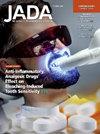Assessing whether breastfeeding is safe after an intraoral injection of 68 mg of articaine
IF 3.1
2区 医学
Q1 DENTISTRY, ORAL SURGERY & MEDICINE
引用次数: 0
Abstract
Background
Limited information is available about the transfer of articaine into breast milk and the associated risks to breastfed infants. As such, health care providers and patients often forgo local anesthesia, postpone dental treatment, or stop breastfeeding after receiving articaine. The authors aimed to evaluate the safety of articaine use in mothers who are breastfeeding by means of examining its pharmacokinetic properties in breast milk and assessing the potential risks to breastfed infants.
Methods
Twelve breastfeeding mothers were randomly assigned to 2 groups and received an injection of 4% articaine (containing 68 mg of articaine) via supraperiosteal infiltration. Group A provided milk samples at various times postadministration, and milk output from group B was measured over the first 3 hours postadministration.
Results
The peak concentration of articaine in breast milk was 256.5 ng/mL at 0.25 hours, and declined to 12.9 ng/mL at 3 hours postadministration. The amount of articaine transferred to breast milk after 3 hours was calculated as 1.12 μg. Pharmacokinetic modeling predicted that the maximum plasma exposure in infants was 0.19 ng/mL, far below toxicity thresholds.
Conclusions
The study findings suggested that breastfeeding mothers can safely resume breastfeeding within 1 through 3 hours after administration of articaine, as the predicted infant exposure was considerably below the concentrations producing a pharmacologic effect.
Practical Implications
The results of this clinical study clarified the safety of using articaine in breastfeeding mothers and the optimal timing for resuming breastfeeding after dental procedures. This clinical trial was registered at the Chinese Clinical Trial Registry (www.chictr.org.cn). The registration number is ChiCTR2400082053.
评估口服注射68毫克阿替卡因后母乳喂养是否安全
背景:关于阿替卡因进入母乳及其对母乳喂养婴儿的相关风险的信息有限。因此,卫生保健提供者和患者经常放弃局部麻醉,推迟牙科治疗,或在接受阿替卡因后停止母乳喂养。作者旨在通过检查阿替卡因在母乳中的药代动力学特性和评估其对母乳喂养婴儿的潜在风险来评估母乳喂养母亲使用阿替卡因的安全性。方法12例母乳喂养母亲随机分为2组,经膜上浸润注射4%阿替卡因(含阿替卡因68 mg)。A组在给药后不同时间提供乳样,B组在给药后前3小时测量泌乳量。结果给药后0.25 h,母乳中阿替卡因浓度峰值为256.5 ng/mL,给药后3 h,阿替卡因浓度下降至12.9 ng/mL。计算3小时后阿替卡因转移到母乳中的量为1.12 μg。药代动力学模型预测,婴儿的最大血浆暴露量为0.19 ng/mL,远低于毒性阈值。结论研究结果表明,母乳喂养的母亲可以在给予阿替卡因后1至3小时内安全地恢复母乳喂养,因为预测的婴儿接触浓度大大低于产生药理作用的浓度。实际意义本临床研究的结果阐明了在母乳喂养的母亲中使用阿替卡因的安全性以及在牙科手术后恢复母乳喂养的最佳时机。该临床试验已在中国临床试验注册中心注册(www.chictr.org.cn)。注册号为ChiCTR2400082053。
本文章由计算机程序翻译,如有差异,请以英文原文为准。
求助全文
约1分钟内获得全文
求助全文
来源期刊

Journal of the American Dental Association
医学-牙科与口腔外科
CiteScore
5.30
自引率
10.30%
发文量
221
审稿时长
34 days
期刊介绍:
There is not a single source or solution to help dentists in their quest for lifelong learning, improving dental practice, and dental well-being. JADA+, along with The Journal of the American Dental Association, is striving to do just that, bringing together practical content covering dentistry topics and procedures to help dentists—both general dentists and specialists—provide better patient care and improve oral health and well-being. This is a work in progress; as we add more content, covering more topics of interest, it will continue to expand, becoming an ever-more essential source of oral health knowledge.
 求助内容:
求助内容: 应助结果提醒方式:
应助结果提醒方式:


